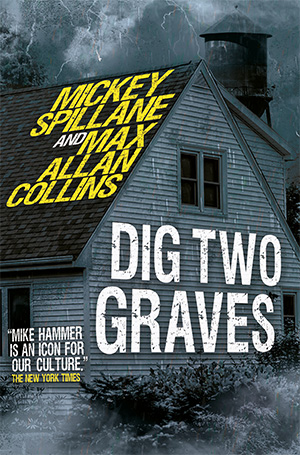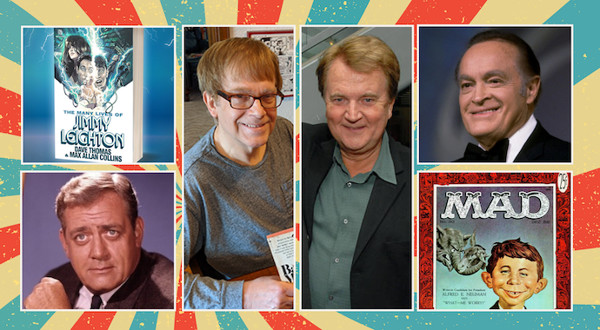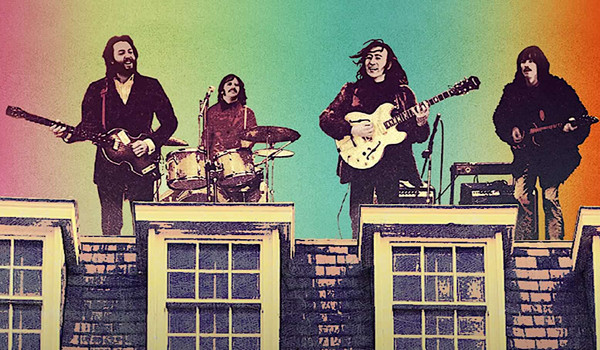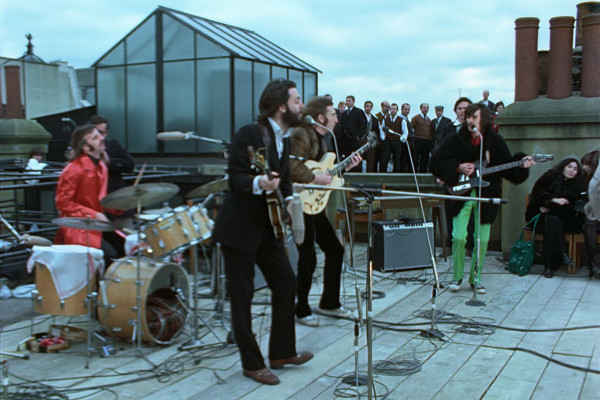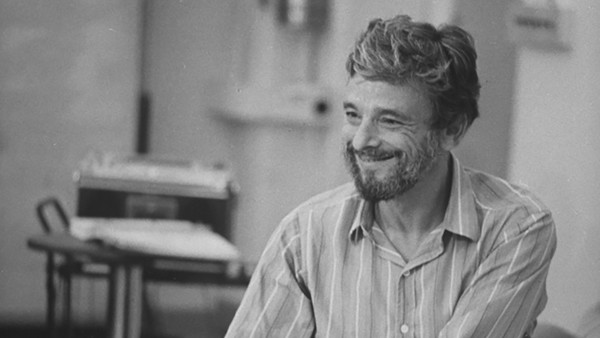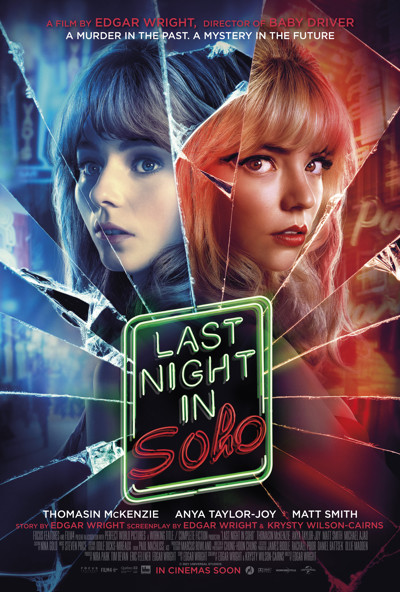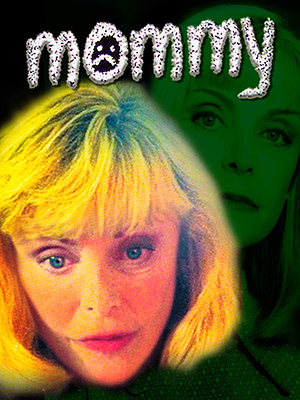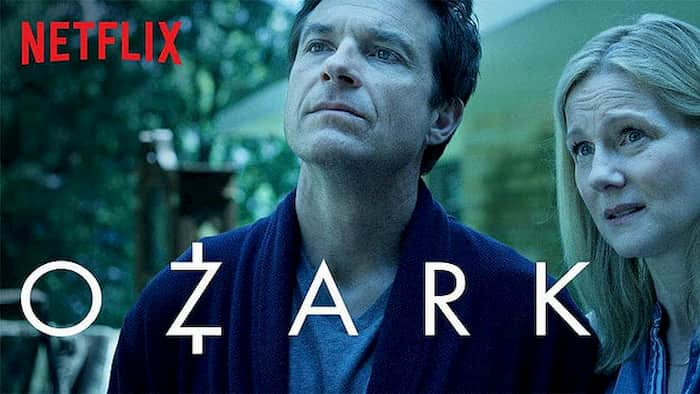A limited book giveaway kicks off this Update.
I have only five copies I can share with you of the new Mike Hammer novel, Dig Two Graves. So move fast.
[All copies have been claimed. Thank you for your support! –Nate]
IMPORTANT: If you recently won a copy of Too Many Bullets, please don’t enter. If you’re not sure whether you were a winner in that giveaway, e-mail me at the above address and I’ll let you know. But before you do, keep in mind that I contacted everyone who entered who did not win and informed them of it. And please don’t tell Nero Wolfe I used “contact” as a verb.
You agree to write a review (or reviews) at Amazon, Barnes & Noble, and/or Goodreads, or your own blog.
Speaking of Dig Two Graves, the great Andrew Sumner of Titan interviewed me about it recently, and you can watch it right here.
Dig Two Graves will be available from Amazon and others a week from today (Sept. 19).
Two of my novels are on sale right now (and until 9/30/’23) at Amazon, e-book editions of Executive Order ($2.95  ) and Girl Most Likely ($2.49
) and Girl Most Likely ($2.49  ). Exec is co-written by Matthew Clemens and is a Reeder and Rogers political thriller. Girl is one of my personal favorites.
). Exec is co-written by Matthew Clemens and is a Reeder and Rogers political thriller. Girl is one of my personal favorites.
Robert Meyer Burnett, You Tube’s finest commentator on pop culture and physical media, made an interesting announcement on air last night (Sunday Sept. 10). All of a sudden he was talking about me! Hearing my name invoked was startling and, I’ll admit, a little thrilling, because I respect this man’s opinions and admire his uncanny ability to hold my attention for literal hours with his good-humored brilliance. But I wasn’t entirely surprised, because he and I (and our mutual friend Mike Bawden, who is the producer of the Burnett podcasts, and happens to be located near me in the Quad Cities) are embarking on a project together.
We are setting out to do a podcast series based on the Nathan Heller novels. Each multi-episode podcast would take on a single book. I will write these adaptations myself. Rob Burnett is, among other things, a Hollywood director (Free Enterprise, Femme Fatales, The Hills Run Red). There will be a crowd-funding effort to get the first podcast off the ground, and I’ve written a 10-page self-contained script (based on the opening of Stolen Away), to be presented as an example of what we’re up to at the crowd-funding site.
These are early days, but I think we’ll be moving fast. We are talking to several terrific name actors about playing Heller on the crowd-funding pilot, and when we’re a go for the podcast (likely six episodes – we’re considering several titles, including Carnal Hours), other name actors will be cast as well.
Since we haven’t had a Heller movie in all these years, despite continued Hollywood interest, I think a superior podcast could really jump start things on that end.
But the podcast on its own will be great fun, and producer Bawden is a genius at promotion and utilizing You Tube. Not surprisingly, my longtime movie collaborator Phil Dingeldein is involved in the project, and we’ll be making behind-the-scenes and behind-the-story “true crime” videos. That, at least, is the plan.
Meanwhile, work on Blue Christmas continues apace.
We are trying to secure Gary Sandy, but he has several prior commitments we have to find a window between. If we don’t land him, he has nonetheless been a friend to me and my work, and incidentally a fan specifically of Blue Christmas. His taking on Mike Hammer for our Golden Age-radio style local production made recording it (and turning it into a modest but fun little movie) possible.
We are having auditions this week for the rest of the Blue Christmas cast, and I intend to use as many of the players from Mickey Spillane’s Encore for Murder as possible. I was very pleased with their work.
Both the Blu-ray of the expanded Mike Hammer’s Mickey Spillane documentary and a DVD of Encore for Murder will be out in December (exact date TBA). Here is the trailer for Encore.
We are on a very fast track for Blue Christmas – the shoot is toward the end of October.
Yesterday afternoon/evening (Sunday Sept. 10), my band Crusin’ made its last appearance of the summer. Rain kept threatening but never happened, and a large appreciative crowd seemed to have a great time.
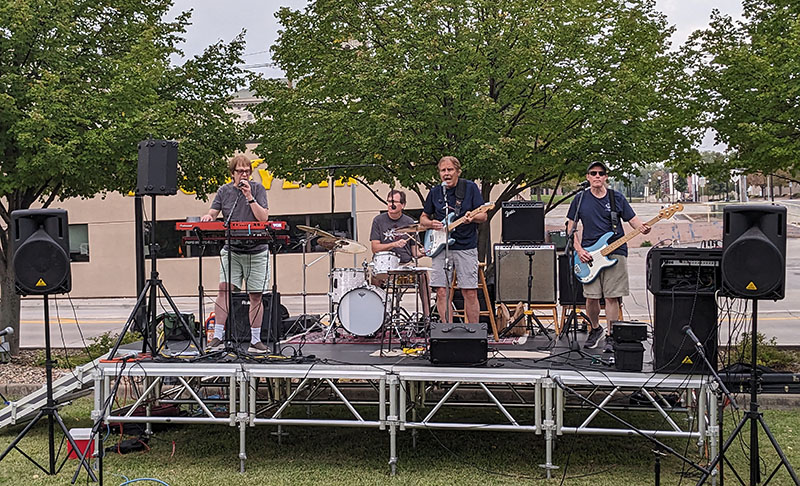

Barbara and Samuel dance to Crusin’
I had to postpone this from a scheduled August appearance, due to my health stuff; but I was pretty much fine for this performance, although I admit to tiring easily. It’s becoming obvious that I’m near the end of my rock ‘n’ rolling days, and I think next summer (if the rest of the band is up for it) we’ll do a Farewell Tour of three gigs here in Muscatine.
We’ve been preparing new originals for one last CD, which would include the Crusin’ originals from Real Time: Siege at Lucas Street Market.
This version of the band has been very gratifying. This is the line-up, basically, that appeared at the 2018 Iowa Rock ‘n’ Roll Hall of Fame induction concert. Our late bass player, Brian Van Winkle, appeared with us there. He passed away not long after, most unexpectedly, and his sunny presence and self-deprecating humor is sorely missed – in many respects he was the heart of the band. His replacement – our guitarist Bill Anson’s son Scott – is one of the best bass players I’ve been privileged to appear with. He has his own sly sense of humor, too. By the way, Bill Anson came aboard just to fill in for a while – that was seven years ago.
I hate to hang it up, but I figure I’ve accomplished everything I ever will in this artistic/performing arena, and will concentrate whatever time is left to writing novels and working on movies. Blue Christmas is, in part, an experiment to see how I do directing a movie at this rarefied age.
I have designed it to be low-budget – a necessity, particularly since we didn’t get the expected Greenlight grant – and wrote it to be shot on a single set in a studio-style setting. I will have some wonderful actors lined up (with or without Gary, though I sure hope he’s able to do it) and great collaborators in Phil Dingeldein, Liz Toal and Chad Bishop.
Since Encore came out well and the filming of it was something of a last minute, impulsive decision, I had originally conceived Blue Christmas to be presented as a play that we’d shoot. There are advantages to that approach, but also disadvantages – shooting it film-style, without an audience, will broaden our market, and be more artistically satisfying to boot.
Wish us break a leg and stay tuned for reports from the front lines.
Here, from the Pulp, Crime & Mystery Books site, is a nice review of Dig Two Graves.
Finally, here’s a short but great write-up on Too Many Bullets from Craig Zablo.
